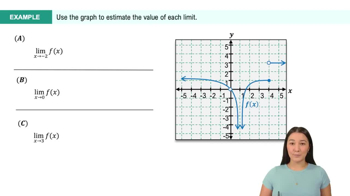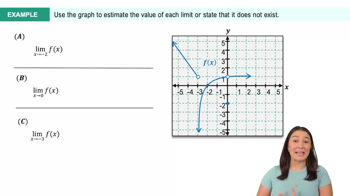Table of contents
- 0. Functions7h 52m
- Introduction to Functions16m
- Piecewise Functions10m
- Properties of Functions9m
- Common Functions1h 8m
- Transformations5m
- Combining Functions27m
- Exponent rules32m
- Exponential Functions28m
- Logarithmic Functions24m
- Properties of Logarithms34m
- Exponential & Logarithmic Equations35m
- Introduction to Trigonometric Functions38m
- Graphs of Trigonometric Functions44m
- Trigonometric Identities47m
- Inverse Trigonometric Functions48m
- 1. Limits and Continuity2h 2m
- 2. Intro to Derivatives1h 33m
- 3. Techniques of Differentiation3h 18m
- 4. Applications of Derivatives2h 38m
- 5. Graphical Applications of Derivatives6h 2m
- 6. Derivatives of Inverse, Exponential, & Logarithmic Functions2h 37m
- 7. Antiderivatives & Indefinite Integrals1h 26m
- 8. Definite Integrals3h 25m
1. Limits and Continuity
Introduction to Limits
Problem 2.21a
Textbook Question
For the following position functions, make a table of average velocities similar to those in Exercises 19–20 and make a conjecture about the instantaneous velocity at the indicated time.
a. s(t)=−16t^2+80t+60 at t=3
 Verified step by step guidance
Verified step by step guidance1
Step 1: Understand the problem. We are given a position function s(t) = -16t^2 + 80t + 60, and we need to find the average velocities over intervals approaching t = 3.
Step 2: Calculate the average velocity over an interval [3, 3+h]. The average velocity is given by the formula: \( v_{avg} = \frac{s(3+h) - s(3)}{h} \).
Step 3: Substitute s(t) into the average velocity formula. Calculate s(3) and s(3+h) using the position function.
Step 4: Simplify the expression for average velocity. This involves expanding s(3+h) and simplifying the difference quotient.
Step 5: Make a conjecture about the instantaneous velocity at t = 3 by observing the behavior of the average velocity as h approaches 0.
Recommended similar problem, with video answer:
 Verified Solution
Verified SolutionThis video solution was recommended by our tutors as helpful for the problem above
Video duration:
12mPlay a video:
Was this helpful?
Key Concepts
Here are the essential concepts you must grasp in order to answer the question correctly.
Average Velocity
Average velocity is defined as the change in position over the change in time. Mathematically, it is calculated using the formula (s(t2) - s(t1)) / (t2 - t1), where s(t) represents the position function. This concept is crucial for understanding how position changes over intervals and is foundational for analyzing motion.
Recommended video:

Derivatives Applied To Velocity
Instantaneous Velocity
Instantaneous velocity refers to the velocity of an object at a specific moment in time. It is determined by taking the limit of the average velocity as the time interval approaches zero. This concept is essential for understanding how an object's speed and direction change at any given point, and it is often represented as the derivative of the position function.
Recommended video:

Derivatives Applied To Velocity
Position Function
A position function describes the location of an object as a function of time, typically denoted as s(t). In this case, s(t) = -16t^2 + 80t + 60 represents a quadratic function that models the motion of an object under the influence of gravity. Understanding the position function is vital for calculating both average and instantaneous velocities.
Recommended video:

Relations and Functions

 6:47m
6:47mWatch next
Master Finding Limits Numerically and Graphically with a bite sized video explanation from Callie
Start learning





